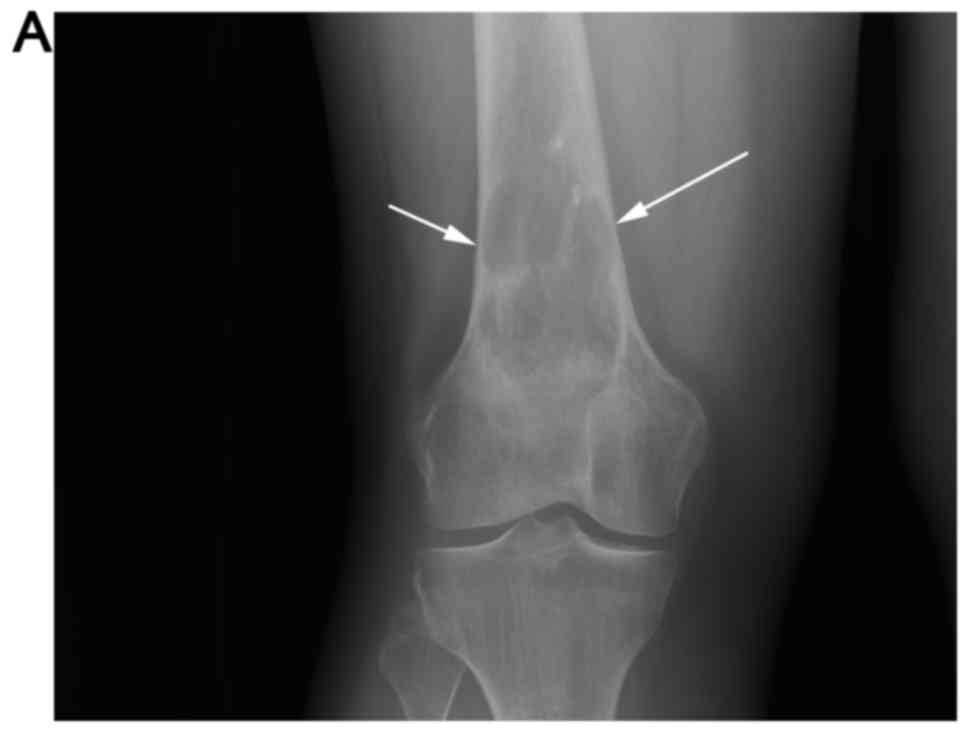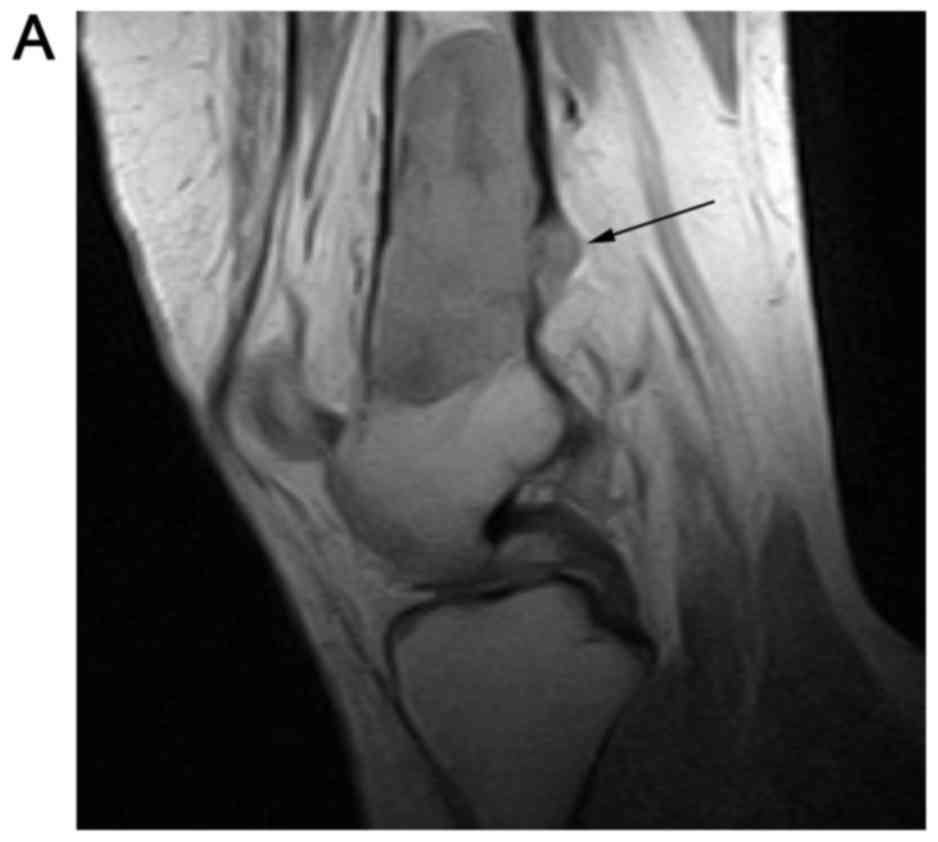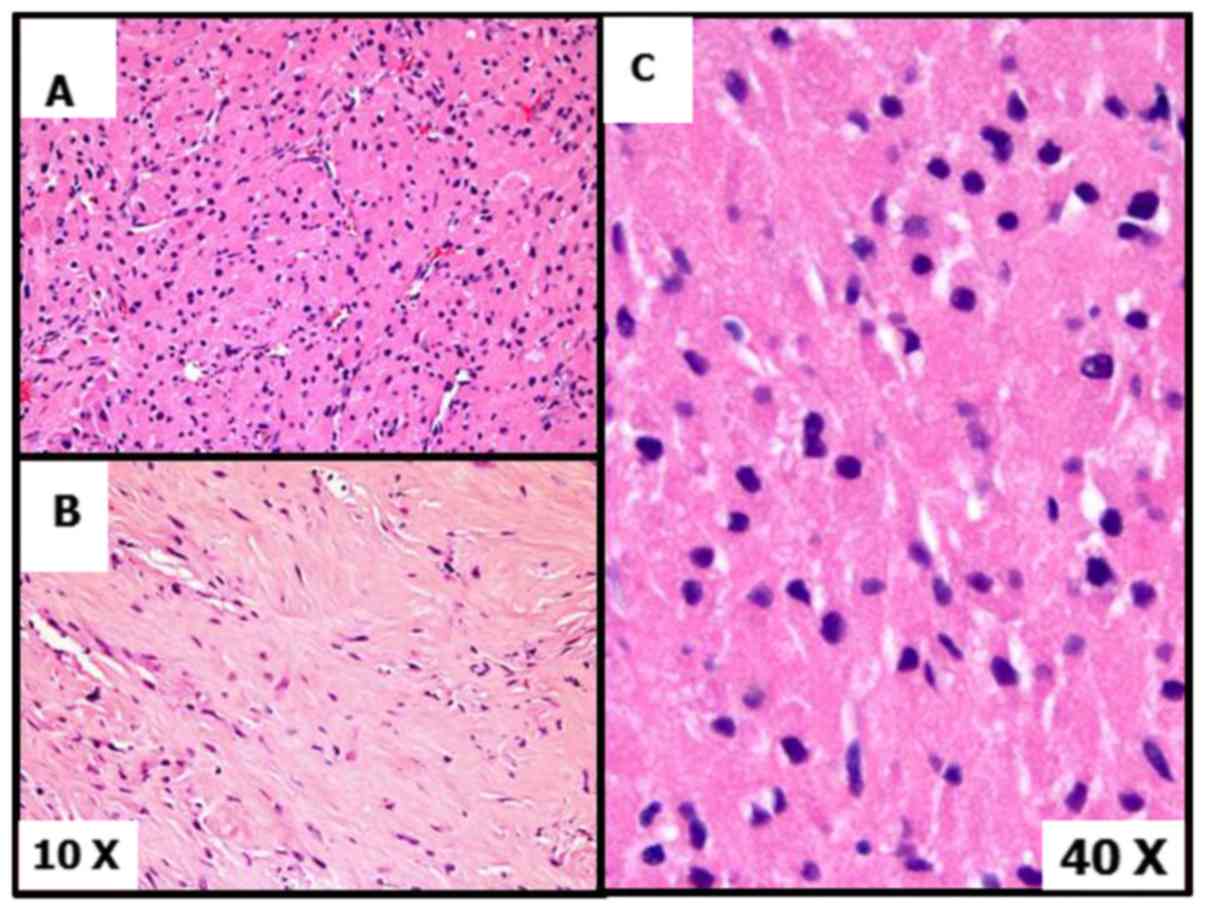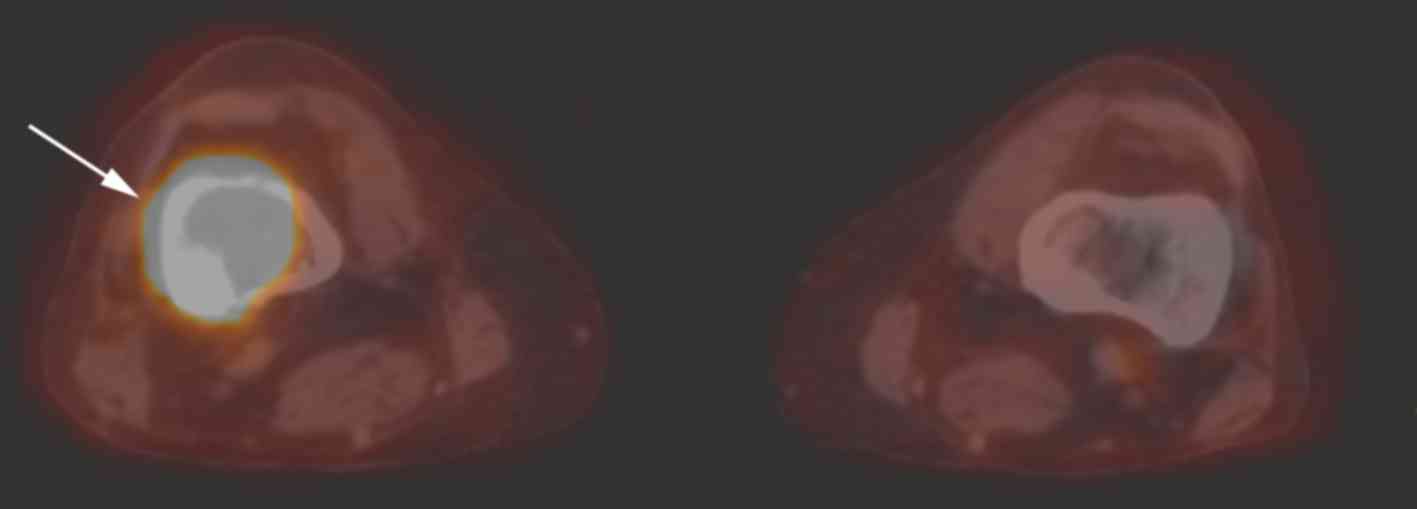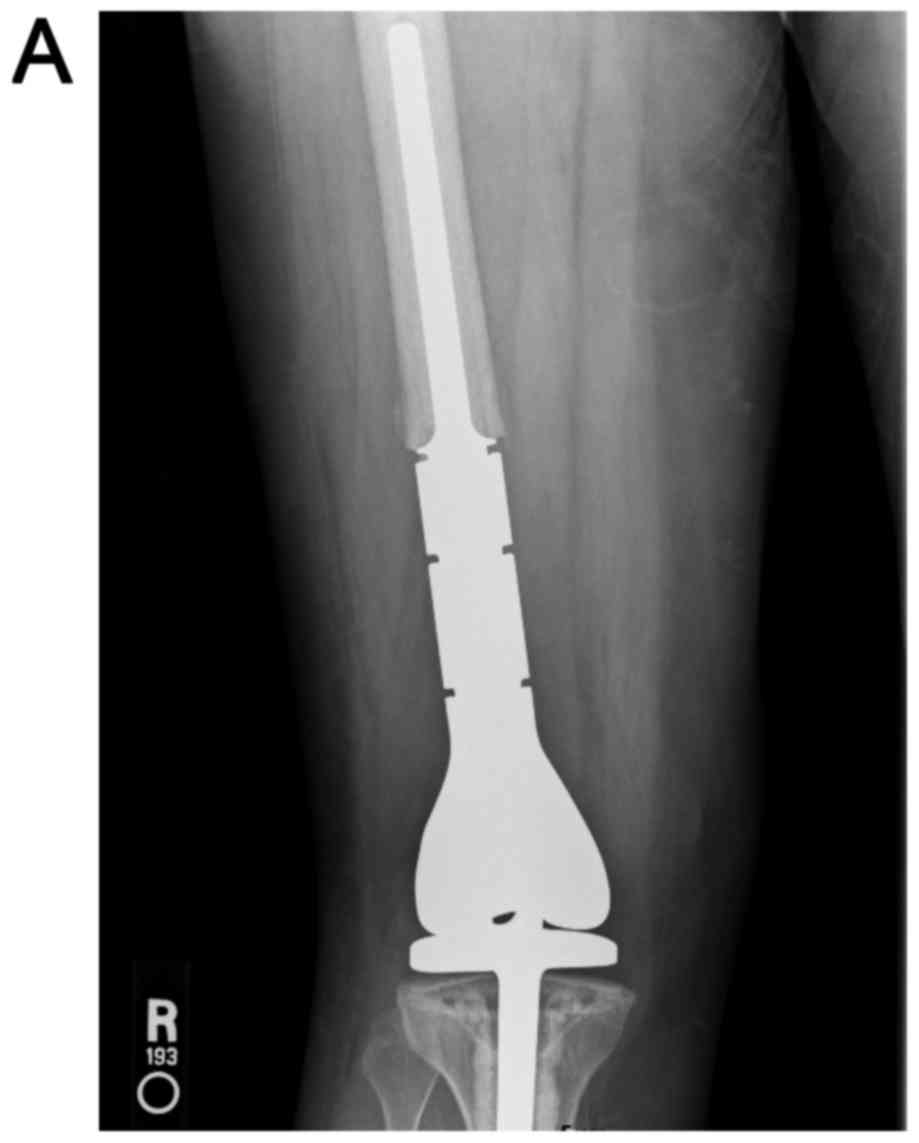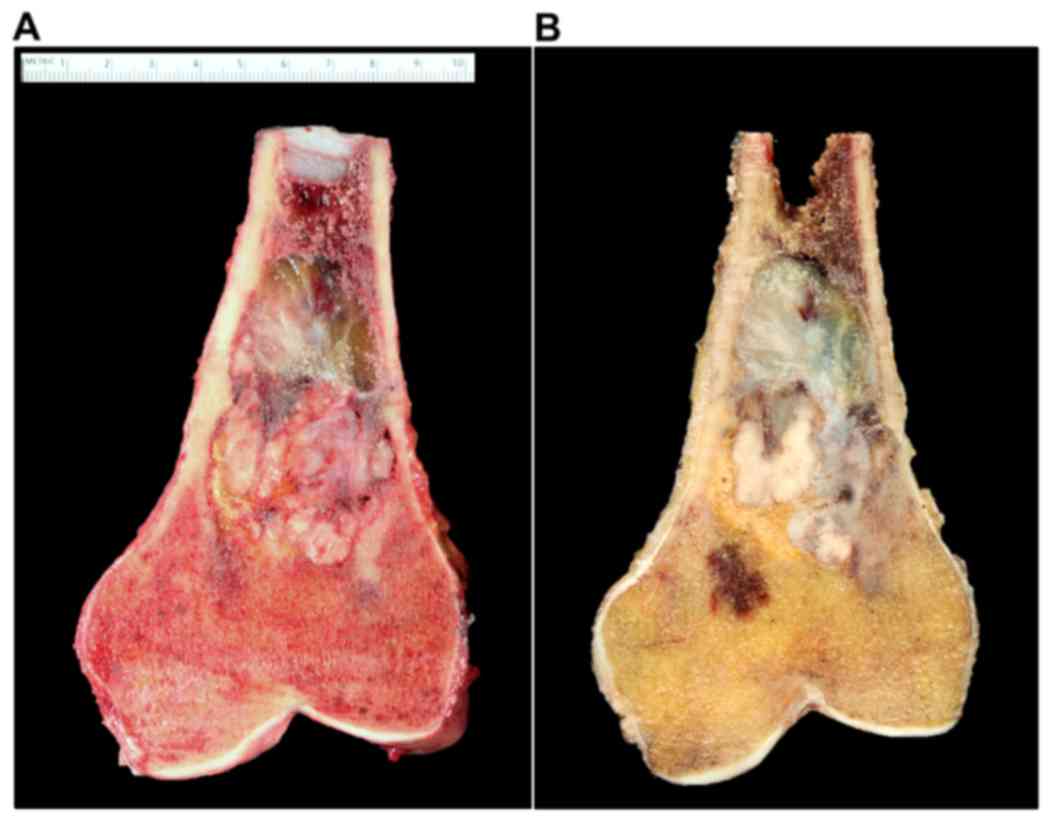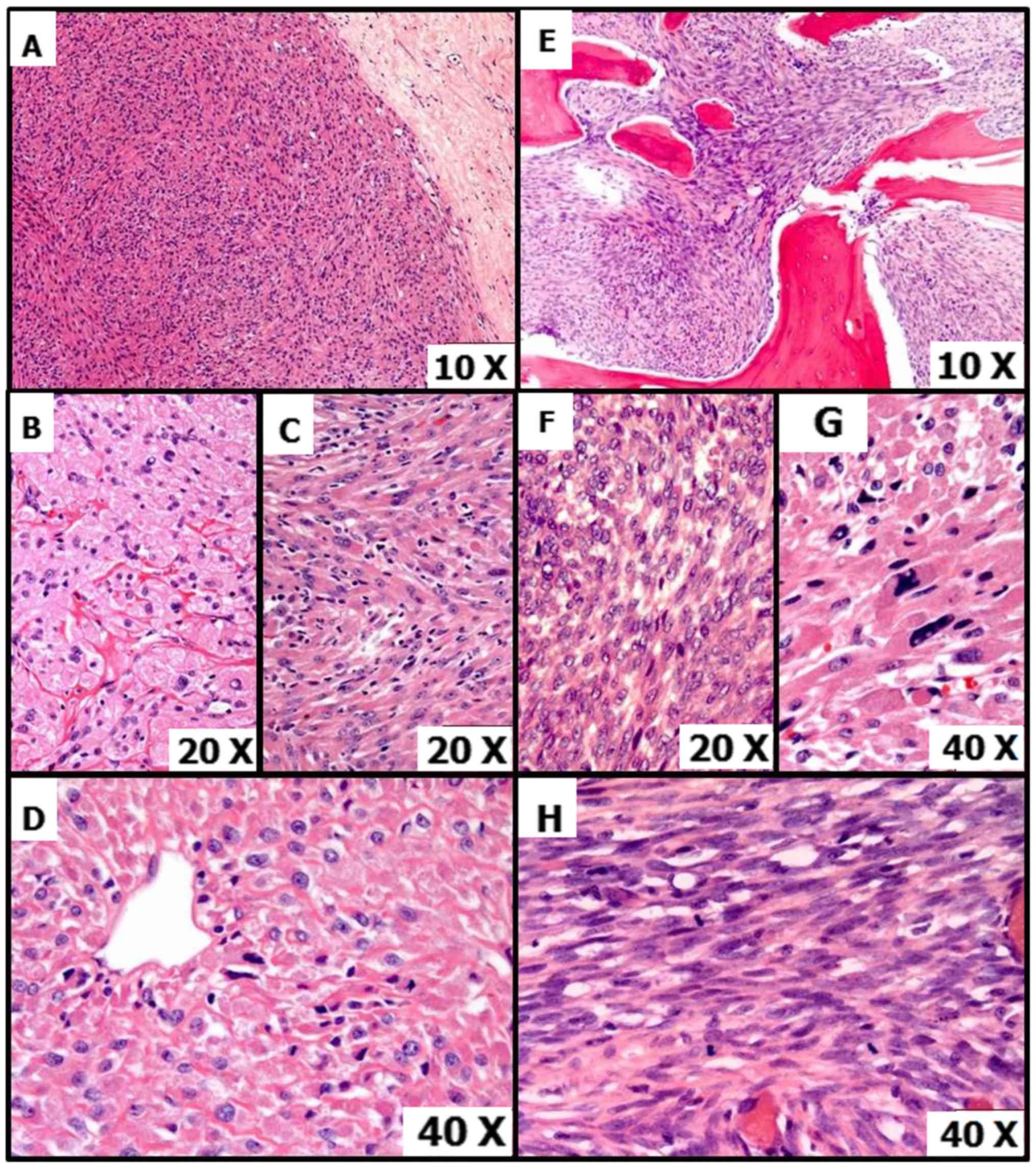Primary malignant perivascular epithelioid cell neoplasm (PEComa) of the bone mimicking granular cell tumor in core biopsy: A case report and literature review
- Authors:
- Published online on: December 20, 2017 https://doi.org/10.3892/ol.2017.7662
- Pages: 2946-2952
-
Copyright: © Sadigh et al. This is an open access article distributed under the terms of Creative Commons Attribution License.
Abstract
Introduction
Perivascular epithelioid cell (PEC) neoplasms (PEComas) are rare mesenchymal tumors composed of PECs. PEC, a cell type that has no known normal counterpart, was coined by Bonetti et al (1) in 1992 in order to describe tumor cells with an epithelioid appearance, perivascular distribution, and co-expression of myogenic and melanocytic markers, most classically Human Melanoma Black 45 (HMB45). Histologically, PEComas typically exhibit both epithelioid and spindled cell morphology, and can be either benign or malignant (2).
While the most prevalent tumors in the PEComa family are angiomyolipoma (AML), lymphangioleiomyomatosis (LAM) and clear-cell (sugar) tumor (CCST) of the lung, other significantly less common manifestations of PEComa have been detected at a variety of visceral and somatic sites throughout the body (3–5). Primary PEComa of the bone is particularly rare, with only 12 reported cases in the literature (6–14). The present study investigated a case of malignant primary bone PEComa presenting in the right distal femur of a 46-year-old female and described the clinical, radiologic and histologic malignant features, in addition to a review of the relevant literature.
Case report
A 46-year-old female with no significant past medical history presented with a 5-month history of right distal thigh pain following trauma. The patient presented to urgent care in 2016 for evaluation following the trauma and obtained radiographs of the right knee and distal femur (Fig. 1A and B). These radiographs revealed a mixed, lytic and sclerotic lesion involving the distal femoral metadiaphysis extending into the epiphysis. The patient's pain progressed and she returned three months later for a repeat evaluation. At that time, the patient reported 5/10 distal thigh pain that was throbbing and aching. The pain was constant. The pain was worse with activity and relieved with rest and non-steroidal anti-inflammatory drugs.
Radiographs of the right distal femur were repeated (Fig. 2A and B), which revealed the lesion to be grossly similar in size when compared with prior radiographs, though with increased cortical scalloping. The patient was referred for further evaluation with magnetic resonance imaging (MRI). The MRI was obtained using a 0.3T Hitachi Airis II scanner (Hitachi Medical Corporation, Tokyo, Japan).
Sagittal T1-weighted sequences were obtained using repetition time (TR) of 900 ms, echo time (TE) of 12.6 ms, slice thickness of 4 mm, interslice gap of 1 mm and acquisition matrix of 256×158 (Fig. 3A). T2-weighted sequences were obtained with TR/TE 6182/125 ms, slice thickness of 4 mm, interslice gap of 1 mm and acquisition matrix of 256×144 (Fig. 3B). The lesion was heterogeneous in T2 signal with three distinct signal intensities noted. The MRI demonstrated areas of cortical destruction with soft tissue extension consistent with an aggressive lesion (Fig. 3B). Coronal T1-weighted sequences (TR/TE 490/15 ms, slice thickness 4 mm, interslice gap of 0.5 mm and acquisition matrix 256×160) exhibited a heterogeneously T1 hypointense and isointense lesion (Fig. 3C). The patient was referred for computed tomography (CT)-guided core-needle biopsy of the lesion at the Hospital of the University of Pennsylvania (Philadelphia, PA, USA). Histologic evaluation of the area of the lesion that had been sampled with the core needle biopsy (Fig. 4A-C) revealed a cytologically bland proliferation of cells, with ample bright granular eosinophilic cytoplasm and dark even chromatin with few scattered enlarged nuclei with inclusions. The cells were in a nested configuration with a rich vascular stroma, and other areas had extensive stromal hyalinization. There was no necrosis or mitotic activity. The morphologic impression was that of a granular cell tumor, although an S100 immunostain was negative and a subsequent extensive immunohistochemical panel was unrevealing. Considering the overall features, the core needle biopsy diagnosis was favored to be an unusual (S100 negative) granular cell neoplasm with extensive stromal hyalinization. Since malignant granular cell tumors are 18fluorodeoxyglucose (FDG)-avid, a PET/CT was performed to evaluate FDG-avidity and assess for additional lesions (Fig. 5). The PET/CT indicated an FDG-avid lesion with a maximum SUV of 28.6, so the lesion was treated as a malignant granular cell neoplasm.
The distal femur lesion was resected with negative margins and the resection gap reconstructed with a distal femoral megaprosthesis and hinged knee replacement (Fig. 6A and B). Gross examination of the tumor revealed a 6.9×3.9×2.9 cm irregular, heterogeneous, firm lesion with an appearance varying from beige to gray in color (Fig. 7A and B). The lesion occupied the majority of the intramedullary cavity with an area of posterior endosteal scalloping and soft tissue extension through the cortex, as noted on prior MRI.
Histology from the resected specimen revealed a heterogenous morphology with various patterns. A number of areas had plump, epithelioid cells with granular cytoplasm, round medium-large nuclei and distinct cell borders. This was concordant with the previous biopsy (Fig. 8A). These cells were predominantly arranged in a nested architecture with individual nests separated from each other by a vascular or hyalinizing stroma, and in areas with a vaguely storiform pattern (Fig. 8B and C). At least focally, characteristic thin vascular spaces were observed, around which tumor cells were arranged tightly or in a radiating manner (Fig. 8D). Other regions had an infiltrative pattern with a spindled morphology, with medium sized spindled cells arranged in interweaving fascicles and containing fibrillar or granular eosinophilic cytoplasm with elongated, ovoid nuclei with prominent nucleoli (Fig. 8E). There were cells present that exhibited marked nuclear pleomorphism (Fig. 8F). Mitotic activity was highest in very cellular epithelioid and spindled areas with >5 mitoses per high power field (Fig. 8G and H). Focal coagulative tumor necrosis was also present.
Tumor cells revealed positivity for smooth muscle actin, Caldesmin, melanoma antigen, epithelial membrane antigen and thyroid transcription factor-1 (TTF-1; nuclear), while being negative for pan-cytokeratin, cytokeratin AE1/AE3, cytokeratin Cam5.2, S100, CKIT, discovered on gastrointenstinal stromal tumors protein 1, DOG-1, Desmin, Paired box 8, Signal transducer and activator of transcription 6, Inhibin, Thyroglobulin, Cyclin D1, microphthalmia associated transcription factor 2 and Human Melanoma Black (HMB45). There was abnormal transcription factor E3 (TFE3; nuclear) expression, although fluorescent in situ hybridization (FISH) did not demonstrate a TFE3 translocation. Due to the negative cytokeratin expression, the TTF-1 reactivity was considered as aberrant reactivity rather than evidence of an epithelial tumor. There was no abnormal loss of SDHB. CD34 and CD31 indicated an extensive vascular network. Based on the morphologic and immunohistochemical findings (co-expression of smooth muscle markers and melanocytic markers), the final pathologic diagnosis on the resected specimen was of a malignant PEComa.
All procedures performed involving human participants were in accordance with the ethical standards of the University of Pennsylvania Health System (Philadelphia, PA, USA) and with the Declaration of Helsinki declaration (1964) and its later amendments or comparable ethical standards. The requirement for informed consent was waived by the local institutional review board.
Discussion
We present a novel case of primary bone PEComa, localized to the right distal femur. The concept of PEComa is relatively recent, arising within the last 25 years: Following Bonetti's description of PECs in 1992 (1), Zamboni et al (15) coined the term ‘PEComa’ in 1996 and the World Health Organization first recognized PEComa in 2002 (16). As a result, numerous rare neoplastic disorders, including renal AML (prevalence ~1–2/1000 individuals) (17), pulmonary LAM (prevalence ~1–2/1,000,000 individuals) (2,18) and CCST of the lung (unknown prevalence, ~50 reported cases) (19–21), now fall within the umbrella term of PEComa. Other forms of PEComa, known as PEC tumor not otherwise specified (PEComa-NOS), are even less common with <300 reported cases (22).
Notably, only 12 cases of primary PEComa of the bone have been reported to date, not including the current case (6–14), with 7 of these classified as malignant. They include a wide age range of patients (mean age 49, range 26–93), with tumors most commonly localized to lower extremities (tibia, fibula, femur and acetabulum) but also occurring in the vertebrae and ribs. Table I summarizes the salient details of each case, including presentation, diagnostic features, treatment and outcomes. Table I also includes details of the present case for comparison.
The etiology of PEComa is unclear. There is no normal cell type analogous to the PEC and no identified precursor lesion. Genetically, AML, LAM and CCST are strongly associated with tuberous sclerosis complex (TSC), an autosomal dominant neurocutaneous disorder caused by TSC1/TSC2 gene mutations and characterized by seizures, intellectual disability and cellular proliferations (23–25). However, no similar genetic association has been established in primary bone PEComa. AML, LAM, CCST and numerous forms of PEComa-NOS have a well-documented marked female predominance (15,17,24,26,27), which suggests a potential role of hormones in pathogenesis. However, this trend is not evident in primary bone PEComa (6/13 existing cases, including the present case, are female), though the total number of cases is too few to be conclusive.
In general, PEComas may be asymptomatic or present with nonspecific pain. All existing cases of primary bone PEComa presented with pain and/or swelling, with PEComas of the vertebral column also causing leg weakness due to cord compression (10,12). Diagnostic workup of bone PEComa involves a combination of imaging, histology, and immunohistochemistry. Based on the existing case studies, there appears to be no consistent protocol in terms of imaging workup, though the majority of studies include at least a radiograph, often followed by CT and/or MRI (11,12). The most common radiographic finding is a mixed lytic and sclerotic lesion, with more aggressive tumors also presenting with soft tissue expansion and cortical destruction on CT or MRI. MRI is likely to exhibit heterogeneous T1 signal hypointensity on T1-weighted imaging and heterogeneous T2 signal hyperintensity on T2-weighted images (10,11,13). Following analysis of local radiologic findings, patients often undergo systemic clinical and radiologic testing for staging and exclusion of metastatic disease.
In addition to imaging, histological and immunohistochemical studies are crucial for the diagnosis of PEComa. These can be carried out following biopsy, intralesional curettage or wide resection of the tumor. Cytologic findings are significant for epithelioid cells with clear and eosinophilic cytoplasm, intermixed with spindle cells. The cells lie adjacent to thin-walled blood vessels. Other findings common in more aggressive cases are high mitotic activity, nuclear pleomorphism, multinucleated giant cells, stromal hyalinization and focal necrosis (7,8,10,11,13,14). PEComas typically exhibit reactivity to both melanocytic (e.g., HMB45, melan-A) and myogenic (e.g., smooth muscle actin, desmin) markers, but not to epithelial markers. The present case is one of only two reported primary bone PEComas with negative staining for HMB45 but positive staining for melan-A, another melanocytic marker. Also, the current case also positively expressed at least one smooth muscle marker, similar to 7/12 of the prior cases. Notably, this case also stained positively for TFE3, a member of the MiT family of transcription factors, albeit FISH did not demonstrate a translocation. TFE3 positivity has been observed in two prior primary bone PEComa cases and other forms of PEComa. In fact, in a study of TFE3 positivity in PEComa cases, Righi et al (9) proposed that PEComa be added to the MiT family of human tumors, which also includes melanoma, alveolar soft part sarcoma, translocation-associated renal cell carcinomas and clear cell sarcoma of soft tissue (9).
The histologic differential diagnosis for bone PEComa includes metastatic melanoma, metastatic carcinoma (e.g., of renal origin), and leiomyosarcoma. These lesions can have similar cytologic presentations, such as mixed epithelioid and spindle cell morphology, though they lack a perivascular distribution. Certain forms of renal cell carcinoma also exhibit TFE3 nuclear immunoreactivity (9). Alveolar soft part sarcoma (ASPS), which is also commonly reactive to TFE3 and presents with eosinophilic cytoplasm and hypervascularity (28), should also be considered in the differential. Immunohistochemistry is crucial for distinguishing primary bone PEComa from other metastatic disease. In contrast to PEComa, leiomyosarcoma and ASPS lack expression of melanocytic markers, metastatic melanoma lacks expression of smooth muscle markers and expresses S-100, and carcinoma expresses epithelial markers (2,10,16,26,28). Therefore, the trifecta of imaging, histology and immunohistochemistry is essential in PEComa evaluation: While radiologic studies are often the first step of the workup and microscopic examination can provide further insights, immunohistochemistry is required for a definitive diagnosis.
In 2005, Folpe and Kwiatkowski (2) established histologic criteria to classify PEComas as ‘benign’, ‘uncertain malignant potential’ or ‘malignant’. Specifically, they suggest that a PEComa be classified as malignant if it exhibits at least two of the following features: i) Tumor size >5 cm; ii) infiltrative growth pattern; iii) high nuclear grade; iv) high cellularity; v) necrosis; vi) mitotic activity >1/50 HPF with subsequent aggressive clinical behavior. Neoplasms fulfilling only one of the six criteria may be characterized as having uncertain malignant potential, while those with none of the features may be considered benign. Based on this system, the current patient's PEComa would be classified as malignant, given its large size, high mitotic rate, infiltrative growth pattern, high nuclear grade and cellularity, and the presence of necrosis. Table I includes malignancy status based on Folpe's criteria for all prior primary bone PEComa cases. It is important to note that malignancy status based on Folpe's histological criteria may not reflect malignancy based on clinical aggressiveness, though the prior cases that involved metastatic disease were all also histologically classified as malignant.
In terms of treatment, resection of bone PEComa is most common and often curative, though chemo- and/or radiotherapy may be necessary in the case of metastatic disease. Prognosis is variable and benign lesions are cured with local resection and malignant lesions develop metastasis in 42.9% (3/7) of cases from Table I. As evident from Table I, long-term follow-up information is not consistently reported, which can make conclusions regarding treatment outcomes challenging. Additional and longer-term studies of patients with primary PEComa of the bone can further understanding of this exceptionally rare but fascinating disorder.
References
|
Bonetti F, Pea M, Martignoni G and Zamboni G: PEC and sugar. Am J Surg Pathol. 16:307–308. 1992. View Article : Google Scholar : PubMed/NCBI | |
|
Folpe AL and Kwiatkowski DJ: Perivascular epithelioid cell neoplasms: Pathology and pathogenesis. Hum Pathol. 41:1–15. 2010. View Article : Google Scholar : PubMed/NCBI | |
|
Martignoni G, Pea M, Reghellin D, Zamboni G and Bonetti F: PEComas: The past, the present and the future. Virchows Arch. 452:119–132. 2008. View Article : Google Scholar : PubMed/NCBI | |
|
Pan CC, Yang AH and Chiang H: Malignant perivascular epithelioid cell tumor involving the prostate. Arch Pathol Lab Med. 127:E96–E98. 2003.PubMed/NCBI | |
|
Vang R and Kempson RL: Perivascular epithelioid cell tumor (‘PEComa’) of the uterus: A subset of HMB-45-positive epithelioid mesenchymal neoplasms with an uncertain relationship to pure smooth muscle tumors. Am J Surg Pathol. 26:1–13. 2002. View Article : Google Scholar : PubMed/NCBI | |
|
Insabato L, De Rosa G, Terracciano LM, Fazioli F, Di Santo F and Rosai J: Primary monotypic epithelioid angiomyolipoma of bone. Histopathol. 40:286–290. 2002. View Article : Google Scholar | |
|
Lian DW, Chuah KL, Cheng MH and Yap WM: Malignant perivascular epithelioid cell tumour of the fibula: A report and a short review of bone perivascular epithelioid cell tumour. J Clin Pathol. 61:1127–1129. 2008. View Article : Google Scholar : PubMed/NCBI | |
|
Torii I, Kondo N, Takuwa T, Matsumoto S, Okumura Y, Sato A, Tanaka F, Nishigami T, Hasegawa S and Tsujimura T: Perivascular epithelioid cell tumor of the rib. Virchows Arch. 452:697–702. 2008. View Article : Google Scholar : PubMed/NCBI | |
|
Righi A, Dimosthenous K and Rosai J: PEComa: Another member of the MiT tumor family? Int J Surg Pathol. 16:16–20. 2008. View Article : Google Scholar : PubMed/NCBI | |
|
Yamashita K and Fletcher CD: PEComa presenting in bone: Clinicopathologic analysis of 6 cases and literature review. Am J Surg Pathol. 34:1622–1629. 2010.PubMed/NCBI | |
|
Desy NM, Bernstein M, Nahal A, Aziz M, Kenan S, Turcotte RE and Kahn LB: Primary perivascular epithelioid cell neoplasm (PEComa) of bone: Report of two cases and review of the literature. Skeletal Radiol. 41:1469–1474. 2012. View Article : Google Scholar : PubMed/NCBI | |
|
Kazzaz D, Khalifa M, Alorjan M, Shaw M, Rezajooi K and Saifuddin A: Malignant PEComa of the lumbar vertebra: A rare bone tumour. Skeletal Radiol. 41:1465–1468. 2012. View Article : Google Scholar : PubMed/NCBI | |
|
Lao IW, Yu L and Wang J: Malignant perivascular epithelioid cell tumor (PEComa) of the femur: A case report and literature review. Diagn Pathol. 10:542015. View Article : Google Scholar : PubMed/NCBI | |
|
Yu H, Zhu X, Sheng H, Gao H, Xiao W and Wang C: Case report primary perivascular epithelioid cell neoplasm of thigh bone: A case report and literature review. Int J Clin Exp Pathol. 9:2487–2491. 2016. | |
|
Zamboni G, Pea M, Martignoni G, Zancanaro C, Faccioli G, Gilioli E, Pederzoli P and Bonetti F: Clear cell ‘sugar’ tumor of the pancreas. A novel member of the family of lesions characterized by the presence of perivascular epithelioid cells. Am J Surg Pathol. 20:722–730. 1996. View Article : Google Scholar : PubMed/NCBI | |
|
Fletcher CDM, Unni KK and Mertens F: World Health Organization classification of tumours: Pathology and genetics of tumours of soft tissue and bone. Cancer. 177:1365–1376. 2002. | |
|
Eble JN: Angiomyolipoma of kidney. Semin Diagn Pathol. 15:21–40. 1998.PubMed/NCBI | |
|
Urban T, Lazor R, Lacronique J, Murris M, Labrune S, Valeyre D and Cordier JF: Pulmonary lymphangioleiomyomatosis. A study of 69 patients. Groupe d'Etudes et de Recherche sur les Maladies ‘Orphelines’ Pulmonaires. Medicine (Baltimore). 78:321–337. 1999. View Article : Google Scholar : PubMed/NCBI | |
|
Gaffey MJ, Mills SE, Askin FB, Ross GW, Sale GE, Kulander BG, Visscher DW, Yousem SA and Colby TV: Clear cell tumor of the lung. A clinicopathologic, immunohistochemical, and ultrastructural study of eight cases. Am J Surg Pathol. 14:248–259. 1990. View Article : Google Scholar : PubMed/NCBI | |
|
Gaffey MJ, Mills SE, Zarbo RJ, Weiss LM and Gown AM: Clear cell tumor of the lung. Immunohistochemical and ultrastructural evidence of melanogenesis. Am J Surg Pathol. 15:644–653. 1991. View Article : Google Scholar : PubMed/NCBI | |
|
Bonetti F, Pea M, Martignoni G, Doglioni C, Zamboni G, Capelli P, Rimondi P and Andrion A: Clear cell (‘sugar’) tumor of the lung is a lesion strictly related to angiomyolipoma-the concept of a family of lesions characterized by the presence of the perivascular epithelioid cells (PEC). Pathology. 26:230–236. 1994. View Article : Google Scholar : PubMed/NCBI | |
|
Bleeker JS, Quevedo JF and Folpe AL: ‘Malignant’ perivascular epithelioid cell neoplasm: Risk stratification and treatment strategies. Sarcoma. 2012:5416262012. View Article : Google Scholar : PubMed/NCBI | |
|
Rakowski SK, Winterkorn EB, Paul E, Steele DJ, Halpern EF and Thiele EA: Renal manifestations of tuberous sclerosis complex: Incidence, prognosis, and predictive factors. Kidney Int. 70:1777–1782. 2006. View Article : Google Scholar : PubMed/NCBI | |
|
Costello LC, Hartman TE and Ryu JH: High frequency of pulmonary lymphangioleiomyomatosis in women with tuberous sclerosis complex. Mayo Clin Proc. 75:pp. 591–594. 2000; View Article : Google Scholar : PubMed/NCBI | |
|
Flieder DB and Travis WD: Clear cell ‘sugar’ tumor of the lung: Association with lymphangioleiomyomatosis and multifocal micronodular pneumocyte hyperplasia in a patient with tuberous sclerosis. Am J Surg Pathol. 21:1242–1247. 1997. View Article : Google Scholar : PubMed/NCBI | |
|
Folpe AL, Mentzel T, Lehr HA, Fisher C, Balzer BL and Weiss SW: Perivascular epithelioid cell neoplasms of soft tissue and gynecologic origin: A clinicopathologic study of 26 cases and review of the literature. Am J Surg Pathol. 29:1558–1575. 2005. View Article : Google Scholar : PubMed/NCBI | |
|
Armah HB and Parwani AV: Perivascular epithelioid cell tumor. Arch Pathol Lab Med. 133:648–654. 2009.PubMed/NCBI | |
|
Folpe AL and Deyrup AT: Alveolar soft-part sarcoma: A review and update. J Clin Pathol. 59:1127–1132. 2006. View Article : Google Scholar : PubMed/NCBI |




